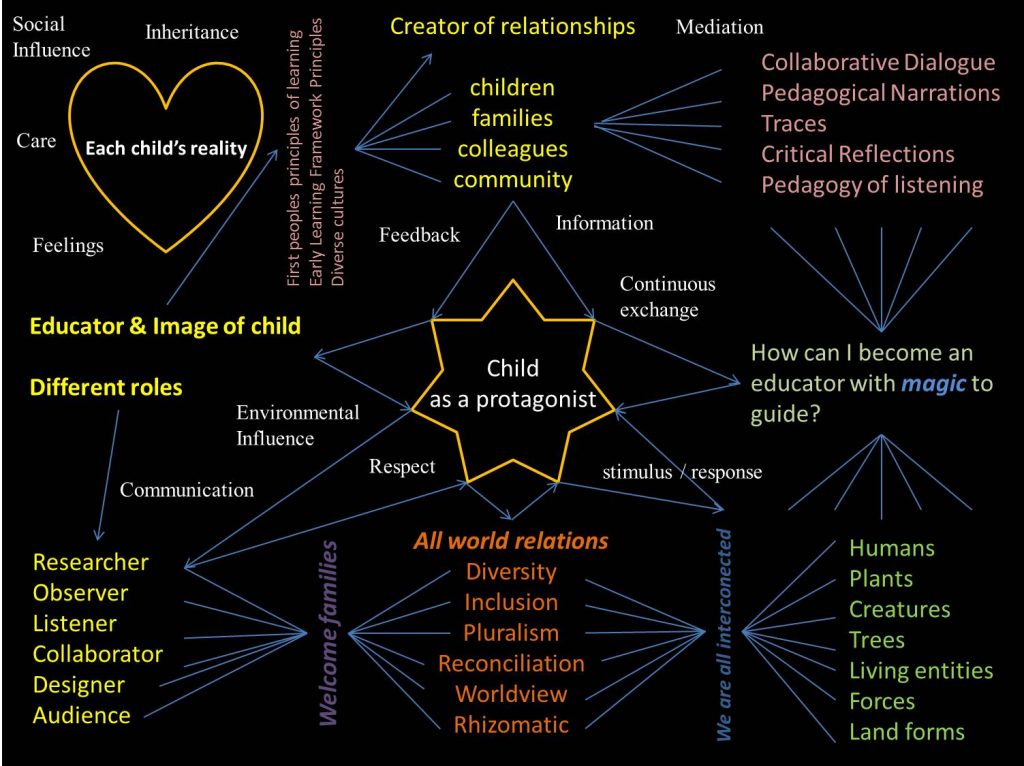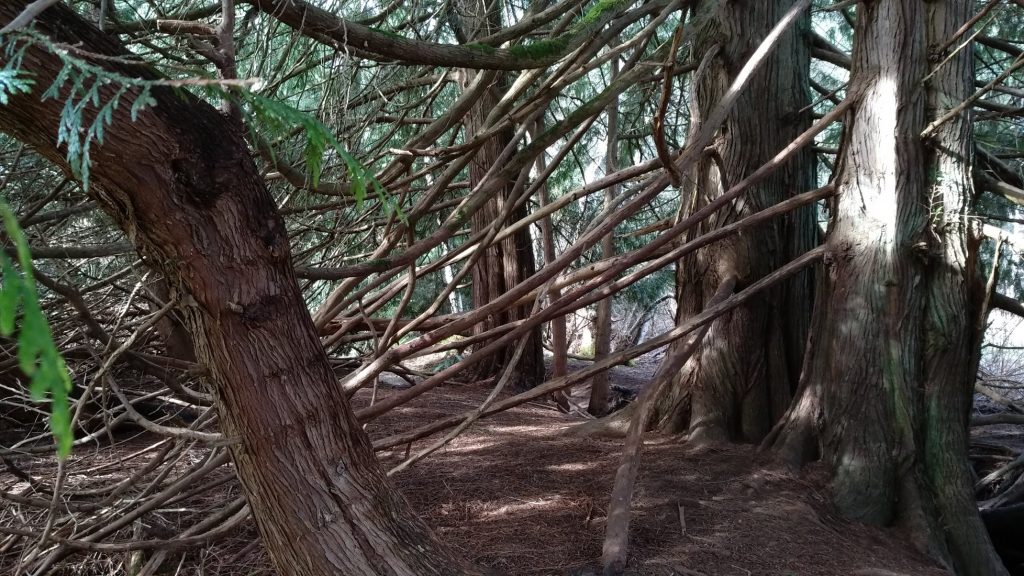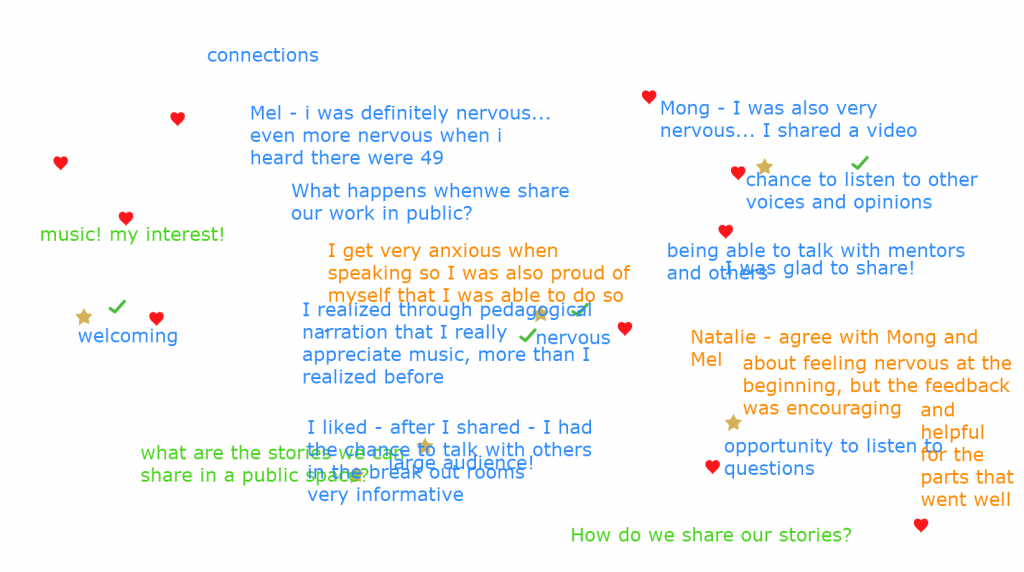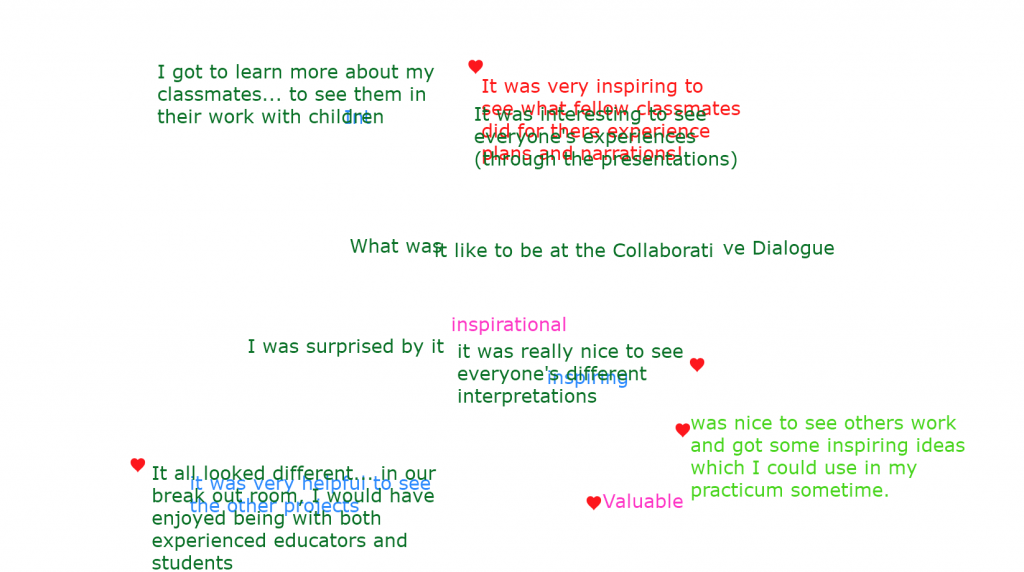In this podcast we welcome our guest Bryndis Gunnarsdóttir who speaks about the Icelandic National Curriculum and the Icelandic context for playschool teachers. With passion, Bryndis also shares her research which examines friendship relations and social interactions in the toddler peer group in an early childhood education and care setting in Iceland using conversation analysis (CA). Throughout the conversation, we weave perspectives of early childhood educators/ playschool teachers, instructors, and students.
We welcome your thoughts and comments,
Antje, Selena, Patricia, and Bryndis
Category Archives: Conversation
Retracing my steps
By Alejandra Gorostiza

The Early Learning Framework (Government of BC, 2019) describes a rhizome as a plant that develops underground and buds in many directions and without a predictable pattern. Inspired by this image, I created this visual map of my learning connections on this wonderful, complex, and unpredictable path to becoming an early childhood educator.
Grateful for so much!
References:
Government of BC. (2019). British Columbia early learning framework. Victoria, BC: Queen’s Printer.
Conversations Through the Fence
By Amanda Gillmore and Jade Felty
Amanda Gillmore and Jade Felty are second year Early Childhood Education and Care Diploma students at Vancouver Island University. In April 2021 they both started their final Infant & Toddler practicum at two different locations in Central Vancouver Island and ended up being next door neighbours. All that was dividing them was a chain link fence.
Within the first few days of Practicum Jade had noticed Amanda and called out to her and waved through the fence. Before this practicum Amanda and Jade had never met in-person, but due to the Pandemic they met in 2020 through the transition of online courses with Vancouver Island University.

“Over the past 5 weeks I have had the opportunity to meet with Amanda through the fence at Practicum. It has been wonderful being able to make contact and connect with another student in my cohort during the isolating times of the Covid-19 pandemic. We exchanged thoughts and feelings about community, connection, our pedagogical narrations, and our lives. On our last visit Amanda and I exchanged letters.” Jade



“I fondly remember the first time that I met Jade in-person. I was outside at my new Practicum Centre, and I heard my name being called, but I didn’t recognize the voice or where it was coming from. I looked up and there waving and smiling through the fence was Jade- my VIU ECEC colleague. Jade and I had only ever met online through our ECEC classes through Zoom. We briefly had a conversation and with agreeance from our Practicum Instructor we decided to meet regularly outside of each of our centre’s sitting along the fence. I had one request that our conversations be organic and focus on each other, self-compassion and heart focused on what each of us needed on that day we would meet. Each week we would check in with one another, normally twice a week, ranging from 30 minutes to 1 hour. It was exactly what both of us needed and we maintained this weekly having our conversations through the fence.” Amanda
Beyond the blog: creating a podcast
Please enjoy this podcast episode about the VIU ECEC blog released by VIU’s Centre for Innovation and Excellence in Learning: https://wordpress.viu.ca/ciel/2021/06/01/episode-15-that-extraordinary-event-that-rippled-out-of-those-beginning-places-heather-wilson-ecec-student-cheryl-cameron-ecec-practicum-coordinator-antje-bitterberg-ecec-ch/
Collaborative Dialogue 2
Dear reader!
The following is a collective response to the second event in the ‘Collaborative Dialogue’ series, a professional development opportunity hosted on March 17, 2021. You will find a brief introduction to this series in our blog post posted on March 8th. We invited presenters, guests, and hosts to co-compose this blog post. Our hope was to sustain the ‘Collaborative Dialogue’ by staying with the generous offerings and creating a space for a playful “back and forth” (see Amanda Gillmore’s post, 2021). We created an online document that updates in real time, shared the invitation to contribute, and waited…
We are connecting to several blog posts shared at the ‘Collaborative Dialogue’:
Sabrina and Julie (forthcoming – on mentorship)
Amanda Gillmore (March 17, 2021)
Vania Zanetti (March 16, 2021)
Kate Boyd and Danielle Cazes (February 23, 2021)
Antje: Welcome to this site for curiosity, experimentation, improvisation, and wonder! You are invited to join this written dialogue inspired by the question: How might we – collectively – continue the ‘Collaborative Dialogue’ event(s) in a virtual way? Here are a few of my questions as a way to enter the conversation, feel free to add your own. What are you compelled to write about as you reflect about the event? What ideas and themes are you returning to? What are some of the alternate stories that you witnessed at the ‘Collaborative Dialogue’ event? What might this dialogue set into motion? What questions are you left with?
Cheryl: Amanda’s swinging boots are an invitation to a child who responds. What are the messages that we send to children, to the world in the way we move? What are the senses beyond words? Toddlers and educators take time to eat their snacks and linger with Sabrina and her mentor Julie. Conversations verbal and otherwise activated by the shared experience of nourishing our bodies and souls. What is activated between us as we think with Vania and Peter Moss?
Antje: I shared Vania’s reflections on play spaces with my sister when we visited Linley Valley Cottle Lake Park in Nanaimo. Inspired by Peter Moss, Vania “wonder[ed] about the multiple ways spaces can provoke exploration”. Their words echoed into this space. We lingered to watch my nephews with/in the trees and stream. This also takes me to Powell River, to the forest, just out of sight, that Kate and Danielle visit with children and their families. How might we cultivate a love for a place? What would the vocabulary be?

Vania: I had asked Sabrina and Julie to speak on their mutual connection to each other. In my reflections I wondered about my own mentor (twenty years ago). I asked myself the same question I asked during the dialogue. What was the moment when I knew I could trust or that I felt connected to my mentor? And I knew the answer. I’ve never forgotten the moment because I use the same words when I work with my colleagues to this day.
There are times for whatever reason when children will be resourceful in getting their needs met. On this particular day a child was not getting what they needed from me (a newbie). Clearly thinking I didn’t know what they were asking they moved on to make the same request from my mentor. My mentor had been an educator in the program for a few years more than myself. My mentor replied with “Vania is right…” and repeated what I had already told the child. Word for word. The child moved on satisfied with the response. To this day I don’t remember what the request was but those three words made me feel so validated, so able, so confident and so trusted. I felt connected knowing they were supporting me in a shared role of caregiver. This was a mentor that saw the importance of stability, consistency and predictability for both the child and a mentee’s emotional development.
Later that day we were able to discuss the moment together. I’m assuming we made changes as may have been needed or perhaps we laughed together at the child’s ingenuity. In reflection the connection happened because my mentor had been vulnerable with me. Not allowing the child to perceive them as ‘greater than’ in that moment made me feel I could be vulnerable together with them. The willingness to be vulnerable made way for connection and trust between us.
When I consider this I think again about the play spaces we create. If dominant language is used when choosing materials, choosing curriculums, and enforcing outcomes how can we be vulnerable with each other? How authentic are our connections with colleagues or the children we care for? How can growth happen when we are not able to make connections that help keep us open to new possibilities?
Collaborative Dialogue: A Series of Community Events
By Students in Practicum II, Ocean Kneeland, and Antje Bitterberg
Creating the event:
The public event ‘Collaborative Dialogue – Learning together and building relationships: A professional development opportunity for early childhood education students, mentors, and curious educators’ is a series of three events imagined and created in collaboration between the VIU ECEC Program and three regional CCRRs: Cowichan, PacificCARE in Nanaimo, and Powell River. When we began to imagine this event, it was important to us to create a space for ongoing dialogue that could hold all of us – students, educators, instructors, and community members in and across our regions. We decided that a series of online events, rather than one, would allow us to nurture a space for dialogue and connections over time. We will share a definition of collaborative dialogue from the Early Learning Framework (Government of BC, 2019), our process for continuing the conversations after the event, and offer some traces of our conversations.
Collaborative Dialogue:
“Collaborative dialogue means inviting comments, questions, and interpretations from children, families, colleagues, and community members to elicit multiple perspectives. This process opens avenues for discussion not to find answers but to explore the different ways of thinking about pedagogy, and to invite reflection on assumptions, values, and unquestioned understandings. Ongoing collaborative dialogue can enrich and deepen perspectives, and can challenge educators to consider new ways of seeing, thinking, and practising.”
(Government of BC, 2019, p. 50)
Revisiting the event with students:
To invite students to reflect on the ‘Collaborative Dialogue’ event, we (Ocean and Antje) visited the students in their practicum seminar a week after the event. We wanted to express our deep gratitude to the four first-year students who shared their pedagogical narrations at the event. We also wanted to acknowledge the students in the audience and their contribution to creating a lively and welcoming space for their peers. In conversation with all the students and their instructor, we learned that many of us embraced uncertainty and an openness to experiment together. Below are two images we created with students to describe what was most meaningful to them.
Students who offered their work at the event shared these reflections:

Students who listened and engaged in the event shared these reflections:

Continuing the Dialogue:
We invite you to share your response to our post or the event by submitting a comment! You might also share your ideas and hopes for future events. What are you curious about and what kinds of professional development opportunities are meaningful to you?
Reference:
Government of British Columbia. (2019). British Columbia early learning framework (2nd ed.). Victoria: Ministry of Education, Ministry of Health, Ministry of Children and Family Development, & British Columbia Early Learning Advisory Group. https://www2.gov.bc.ca/gov/content/education-training/early-learning/teach/early-learning-framework
Note to the World
By Amanda Gillmore
Communication has always been a struggle for me- whether it is communication on paper, in an email, a text message or I verbally need to express myself- I always hesitate and/or second guess myself. You wouldn’t think that if you met me! But, it stems from my childhood and is something that I am working on- it’s not an easy task but working with a Counsellor has helped me and given me the tools to work through this barrier.
At first when I saw the requirements for this weeks’ course content, I immediately became uncomfortable. My course instructor asked us to “create a hand-written/ typed/ or video recorded note to a friend/ family member/ colleague/ mentor/ classmate.” <Insert anxiety NOW.> But, after a cup of Earl Grey Tea and reminding myself to consider this ‘a brief note to invite conversation’, I pressed through. I started off by reading the article ‘Your Image of the Child’ by Malaguzzi (1993). And, here is my Note to the World:
Dear Mentor,
I sincerely appreciate how you have guided me so far through my practicum experience and showing me that “the ability to enjoy relationships and work together is very important” (Malaguzzi, 1993, p.2). Over the last few weeks we have had numerous heart to heart conversations about the importance of child-child relationships, child-educator relationships and educator-educator relationships. I recently read an article in one of my ECEC courses called: ‘Your Image of the Child: Where Teaching Begins’ written by Loris Malaguzzi. I would kindly like to share with you a passage that resonated with me:
“When you enter the school in the morning, you carry with you pieces of your life — your happiness, your sadness, your hopes, your pleasures, the stresses from your life. You never come in an isolated way; you always come with pieces of the world attached to you. So the meetings that we have are always contaminated with the experiences that we bring with us.” (Malaguzzi, 1993, p.2)
Each morning I invite you and the other educators to enter a safe heart space and each ask yourself what pieces of your life are attached to you as you enter the school. This passage I have shared with you has made me more aware and mindful how I want to start each day- whether I will be at my practicum site, starting one of my ECEC online courses or starting my morning rituals at home. I hope sharing this will do the same for you.
Amanda
References
Malaguzzi, L. (1993). Your image of the child: Where teaching begins. Exchange (3).
